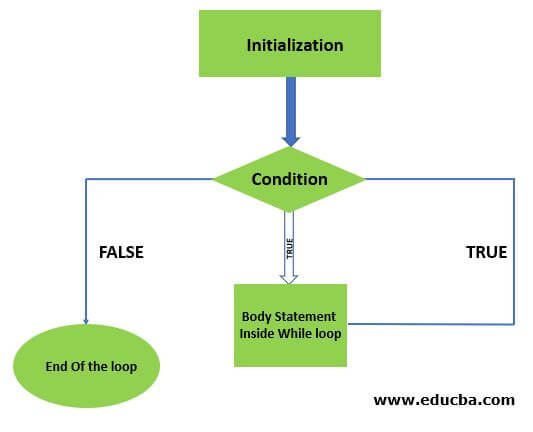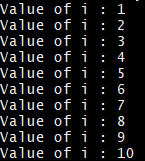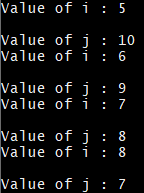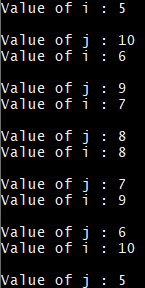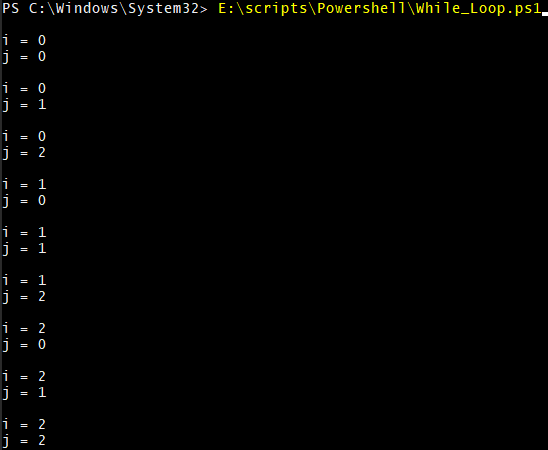Updated June 23, 2023
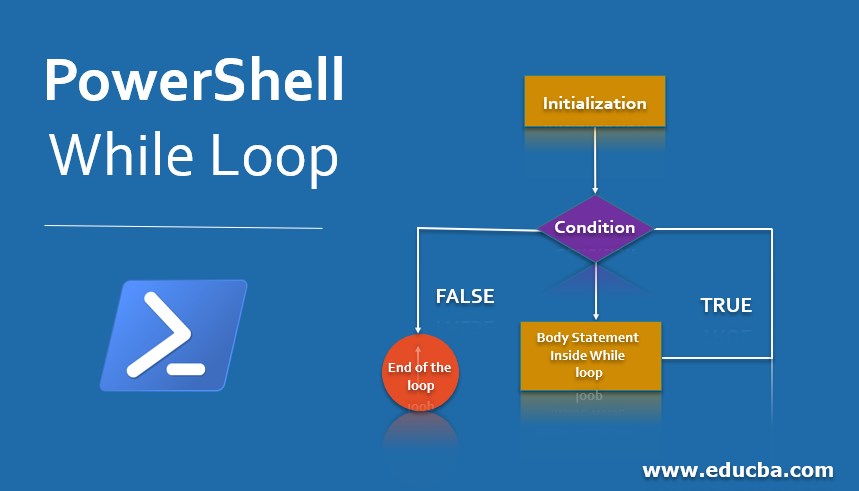
Introduction to PowerShell While Loop
While loop in PowerShell is an iterative loop, which runs until the condition satisfies. You can write multiple lines of code inside the while block and run it several times until the criteria are met. It is like FOR loop, but the structure is different.
Diagram:
Syntax:
While (condition) {
Operation commands
}
Parameters:
- Condition: Conditional parameter is specified here. This condition may be one or more, and the output will be in the Boolean format ($True or $False). While loop runs based on this condition, the loop is terminated automatically once the condition is false.
- Operation Commands: These commands can be simple or complex commands. It runs whenever the condition is satisfied.
The above syntax is equivalent to,
while (true) {
if (!condition)
break;
statements;
}
How PowerShell While Loop Works?
During the While block in PowerShell, variables and other parameters are initialized first, and then there is a condition check. The condition can be one or more, and based on the condition, if it becomes true, then it executes the Body function; again, it repeats the check after executing the body part; and if the condition is satisfied again, it executes the body part again. This same process repeats until the condition becomes false. Once the condition is false, the loop is terminated.
If the condition is initially false, the script will not go inside the body function. However, remember to specify a condition or command that can eventually terminate the loop; otherwise, the loop will be executed forever. You can also terminate the execution of a block with the BREAK command when the specific criteria are met or skip the current iteration using the CONTINUE statement.
Examples of PowerShell While Loop
Let us see some of the examples of while loop in PowerShell, which are given below:
Example #1 – Using Simple While Loop
The script below will initialize the variable $i=1 and execute the while loop. Here the condition $i value 1 is less than equal to 10, so it enters into the body statement and executes the Write-Output command and then increments the value of $i to 2 and then again checks the condition and enters into a loop. The same process works until the $i value reaches 11, the condition gets false, and the loop is terminated. If you don’t put $i++, the loop executes forever, as the script can’t find any termination condition.
Code:
$i=1
while($i -le 10){
Write-Output "Value of i : $i"
$i++
}
Output:
Example #2 – Multiple Conditions with –AND Operator
Code:
$i=5
$j=10
while(($i -le 10) -and ($j -ge 7) ){
Write-Output "Value of i : $i"
Write-Output "`nValue of j : $j"
$i++
$j--
}
Output:
In the above example, if any of the conditions get false (When $i value becomes more significant than 10 and $j value becomes less than 7), then the loop terminates. When the value of $j first reaches 6, it fails to satisfy the while loop condition and terminates the loop.
Example #3 – Multiple Conditions with -OR Operator
Code:
$i=5
$j=10
while(($i -le 10) -or ($j -ge 7) ){
Write-Output "Value of i : $i"
Write-Output "`nValue of j : $j"
$i++
$j--
}
Output:
In the –OR condition, if any of the two statements satisfy, then the loop gets executed.
Example #4 – Condition Inside the While Loop
Like normal functions, you can specify conditions inside the while loop.
Code:
$i=5
while($i -ge 10){
if($i -eq 8){
Write-Output "Variable value reached to 8"
}
$i++
}
Output:
Example #5 – While Loop with Break Statement
As shown in the above example, the loop executes until the while condition is satisfied, but if we want a loop to be terminated when if condition is met, then we need to use the Break command. Once the break command is executed, it terminates all the loops (Parent and Child).
Code:
$i=5
while($i -le 10){
if($i -eq 8){
Write-Output "Break command is going to run now"
Break
}
Write-Output "After break this will not executed"
$i++
}
Output:
In the above example, the IF block executes when the variable value reaches 8 in the IF statement. After executing the break, it terminates the entire loop. You can see the difference in the above two examples.
Example #6 – While Loop with Continue Statement
When executing the CONTINUE statement, it skips the current loop and returns to the main loop. In the below example, when the value reaches 8, it skips the rest of the program and returns to the main WHILE loop.
Code:
$i=5
while($i -le 10){
$i++
if($i -eq 8){Continue}
Write-Output $i
}
Output:
Example #7 – Nested While Loop
You can also use the nested WHILE loop. See the example below.
Code:
$i=0
$j=0
while($i -lt 3){
While($j -lt 3){
Write-Output "`ni = $i"
Write-Output "j = $j"
$j++
}
$i++
$j=0
}
Output:
In this example, the script executes the main while loop first for the $i value of 0; then, it runs the entire inner while loop. Again for the $i=1, the script executes the inner while loop, and it continues until the value of $i meets the condition.
Example #8 – While loop with $TRUE
You can also structure while loop as below.
Code:
$i = 5
while($true){
Write-Output $i
if($i -eq 8){Break}
$i++
}
Output:
In the above example, while loop executes forever because the $true is specified in the condition. To terminate the loop, use the Break command when the condition satisfies.
Conclusion
Although the while loop shares functionality with other loops like FOR, FOREACH, and Do-While, the Do-While loop executes the body statement first and checks the condition later.
Recommended Articles
This is a guide to PowerShell While Loop. Here we discuss the syntax and working of PowerShell While Loop, examples, and code implementation. You may also have a look at the following articles to learn more –
